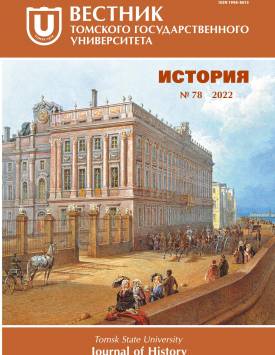Interethnic division of labor in the Trans-Baikal region according to the census of 1897
The interethnic division of labor in the Trans-Baikal region at the end of the XIX century is considered. Analysis of the 1897 census data for the Trans-Baikal region showed that a total of 676,500 people were counted, including 170253 amateur persons and 506247 persons living at their expense. The occupations of the population as a whole provided a simple reproduction of the labor force. Of the total number of the amateur population, 123,373 or 72.5% belonged to the alien peoples, 46,881 or 27.5% - to the Siberian indigenous peoples, 342555 or 67.7% of the dependents belonged to the alien peoples, and 163692 or 32.3% - to the Siberian indigenous peoples. The share of self-employed persons among the alien population was 26.5%, among the indigenous population of the region - 22.3%. The difference of 4.2% indicates the presence of a significant number of workers who came to work from outside the region and stayed for the winter. The population who came from Europe was employed in all spheres of activity, most of all - in agriculture - 60115 (48.7%), in industry - 20198 (16.4%), in service - 10691 (8.7%), existed at the expense of rent - 3855 (3.1%), engaged in trade -4333 (3.5%), in transport and communications - 3879 (3.1%), in military service - 6905 (6.0%), in management - 1408 (1.1%), engaged in forestry - 677 (0.5%), were in penitentiary institutions - 2675 (2.2%), were engaged in fishing and hunting - 386 (0.3%), animal husbandry - 2272 (1.8%), in education and medicine - 1114 (0.9%), in correction of religious cults - 616 (0.5%), etc. The Jews, for whose exile to Siberia, along with the Kainsky and Mariinsky counties of the Tomsk province, the Verhneudinsky and Barguzinsky districts of the Trans-Baikal Region were identified, settled mainly in cities, engaged in handicrafts and trade. Waste workers from China were engaged in the construction, probably, of the railway. Nomadic cattle breeding was the main thing in the life of the Buryat population of the region. A feature of the estate status of the Buryats of Transbaikalia was the entry of a significant number of them into the Cossacks with the corresponding military duties. The main occupation of the Tungus was also traditional cattle breeding, but agriculture turned into their main occupation, as well as the alien population - Russians and other immigrants from European Russia. The Tunguses of the Barguzin district, like their relatives in other taiga regions of Siberia, were engaged in fishing and hunting. The author, based on the 1897 census data, proves that the interethnic division of labor took place mainly between the newcomers and the indigenous population of the region. The author declares no conflicts of interests.
Keywords
Trans-Baikal region, interethnic division of labor, economic development, Russians, Buryats, TungusesAuthors
| Name | Organization | |
| Zinoviev Vasiliy P. | Tomsk State University; Tyumen State University | vpz@tsu.ru |
References

Interethnic division of labor in the Trans-Baikal region according to the census of 1897 | Tomsk State University Journal of History. 2022. № 78. DOI: 10.17223/19988613/78/19
